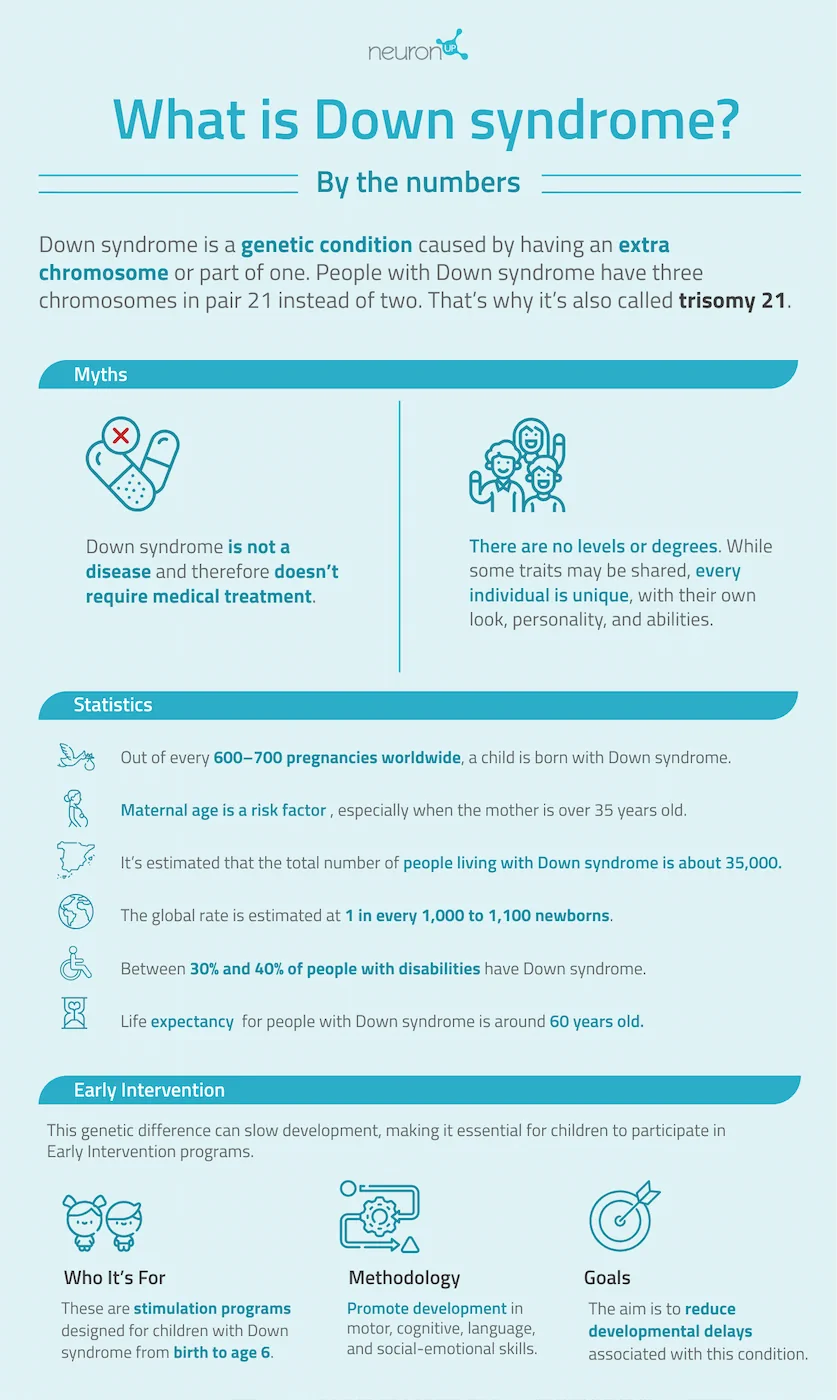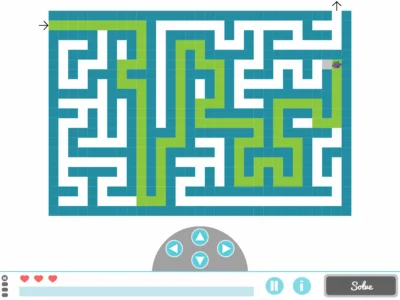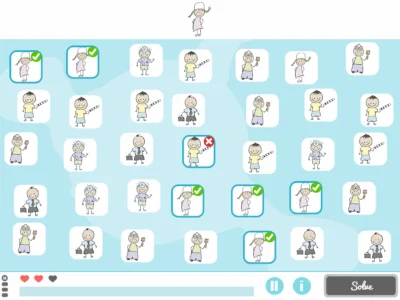Down syndrome from a social perspective
There are many myths and false ideas about people with Down syndrome, so at NeuronUP we want to dispel false beliefs and thus improve their social inclusion. In addition, we discuss the importance of early intervention and present the main figures of this genetic disorder in infographic form.
What is Down syndrome?
Down syndrome is not a disease. It is a genetic alteration caused by the presence of an extra chromosome or a part of one. People with Down syndrome have three chromosomes in pair 21, when normally there are two, so this syndrome is also called trisomy 21. It is the most common human genetic alteration, but it is not a disease and therefore does not require any medical treatment.
The origin of this intellectual disability lies in the contribution by the sperm or the egg of one more chromosome which, when joined to the other 23, total 47 instead of the usual 46. In the vast majority of cases the extra is usually contributed by the egg. There is no known cause for this genetic alteration. It occurs spontaneously and cannot be prevented.
Figures
- For every 600–700 conceptions worldwide, one person with Down syndrome is born.
- The estimated global incidence of Down syndrome is between 1 in 1,000 and 1 in 1,100 newborns.
- In Spain it is estimated that around 35,000 people live with Down syndrome, and a total of six million worldwide.
- Between 30% and 40% of people with disabilities have Down syndrome.
- The life expectancy of people with Down syndrome is around 60 years.
- It has also been shown that maternal age is a risk factor, mainly when the mother is over 35 years old.

Myths and truths
Below, we delve into the main myths surrounding Down syndrome.
Are there different degrees?
There are no degrees. Each person is different and has different characteristics and a different alteration.
Can Down syndrome be inherited?
In most cases, the syndrome arises randomly. Only, in approximately 1% of cases, does the so-called translocation occur, which implies that one of the parents carries a chromosome 21 and part of another, since the missing part has attached to another chromosome. It is in this case that we could speak of it as hereditary.
Aggression is part of Down syndrome
Behavior is not associated with the syndrome, that is, aggressive behaviors originate in conduct disorders that are also present in people without intellectual disabilities.
Life expectancy is low
The life expectancy of people with Down syndrome is over 60 years, a figure that is continuously increasing, as recent advances in medicine are reducing the mortality rate.
Advanced parental age as a cause
Although it has been shown that a factor that increases the likelihood of Down syndrome is that the mother during pregnancy is of an older age, most cases occur in young mothers.
Main cause of intellectual disability
Down syndrome is the main cause of intellectual disability. Between 30% and 40% of people with intellectual disability have this syndrome. This genetic alteration causes a slower development, so it is essential that these children attend stimulation programs from birth known as Early Intervention.
Risk of developing Alzheimer’s
Adults with Down syndrome have a greater risk of developing Alzheimer’s, a neurodegenerative disease that involves the progressive loss of memory.
Down syndrome involves learning difficulties and special education needs
It is true that their learning is slower, but with appropriate stimulation their brain can develop. Furthermore, they do not need special education, and there have been cases of people with Down syndrome who have studied at university and graduated, such as Pablo Pineda, the first person with Down syndrome in Europe to obtain a university degree.
On the other hand, within the labor market the rate of people with this disability holding positions outside special employment centers has increased considerably.
The importance of Early Intervention
Down syndrome has no cure. But there are early intervention programs aimed at children with Down syndrome between 0 and 6 years old that seek to reduce the developmental delay associated with this disability by taking advantage of the neuroplasticity of the brain, that is, the potential the brain has to modify itself and adapt.
In short, these programs aim to stimulate psychomotor, cognitive, language and socio-affective development.
Finally, it should be emphasized that there is no relationship between physical features and cognitive development.
Frequently asked questions about Down syndrome
1. What is Down syndrome?
Down syndrome is a genetic condition caused by an extra copy of chromosome 21 (trisomy 21); it is not a disease and does not require medical treatment for the syndrome itself.
2. Can Down syndrome be inherited?
Most Down syndrome cases occur spontaneously; about 1% result from a translocation in which a parent carries chromosome 21 material, making those rare cases potentially heritable.
3. How common is Down syndrome?
Down syndrome occurs in about 1 in 1,000–1,100 newborns worldwide and roughly 1 in 600–700 conceptions, with millions of people living with the condition globally.
4. Is aggression part of Down syndrome?
Aggression is not an intrinsic feature of Down syndrome; aggressive behaviors stem from conduct disorders that can affect people both with and without intellectual disabilities.
5. What is the life expectancy for people with Down syndrome?
Current life expectancy for people with Down syndrome is around 60 years or more, and continues to increase due to advances in medical care and reduced mortality.
6. Why is early intervention important for Down syndrome?
Early intervention for children with Down syndrome (0–6 years) leverages neuroplasticity to stimulate psychomotor, cognitive, language, and social development and reduce developmental delays.
If you liked this article about the myths and truths of Down syndrome, you may also be interested in these articles:
“This article has been translated. Link to the original article in Spanish:”
Síndrome de Down: qué es, cifras, mitos y verdades







 Attention and Inhibition Rehabilitation in ADHD
Attention and Inhibition Rehabilitation in ADHD
Leave a Reply